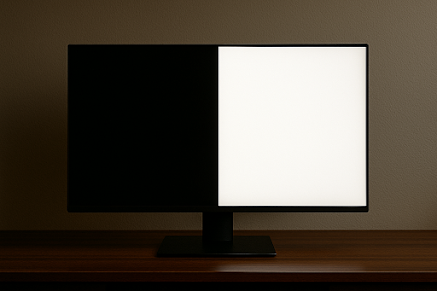Boost Your Sleep with This Dark Screen Trick After Sunset
Late-night screen time can wreak havoc on your sleep, leaving you restless and fatigued. The culprit is blue light from your phone, tablet, or laptop, which mimics daylight and disrupts your body’s natural sleep signals. But a simple, effective trick—using dark screens after sunset—can revolutionize your digital sleep hygiene, helping you rest better and wake up refreshed. In this article, we’ll dive into how dark screens protect your sleep, provide a step-by-step guide to implement this hack, and explore how display innovations, like those preventing OLED burn-in and optimizing monitor calibration, enhance both sleep and screen performance.
How Blue Light Disrupts Your Sleep
Blue light from screens suppresses melatonin, the hormone responsible for regulating sleep, tricking your brain into thinking it’s daytime. After sunset, when natural light dims, the bright, cool-toned glow of your device creates a harsh contrast, straining your eyes and delaying sleep onset. This is especially challenging for night owls—whether you’re working late, gaming, or editing photos. Dark screens minimize light output, reducing this disruption and promoting better rest. Interestingly, modern display technologies tackle similar challenges by adjusting brightness and color to protect both user comfort and screen longevity, as seen in techniques for preventing OLED burn-in.
The Dark Screen Trick: A Simple Fix
Switching to a dark screen after sunset is a quick way to improve your sleep hygiene and reduce eye strain. This hack leverages your device’s built-in features to create a sleep-friendly display in seconds. Here’s how to do it:
Step-by-Step Guide
Activate Dark Mode: Enable dark mode in your device’s display settings. On iOS, go to Settings > Display & Brightness > Dark. On Android, select “Dark Theme” under Display. For laptops, many apps, like browsers or code editors, offer dark mode options.
Dim the Brightness: Lower your screen’s brightness to the minimum comfortable level. This reduces light emission, aligning your screen with the dim evening environment and easing eye strain.
Add a Blue Light Filter: Combine dark mode with a warm color temperature (1900K–3500K) using Night Shift (Apple), Night Light (Windows), or Blue Light Filter (Android). This further cuts blue light, mimicking the warm glow of sunset.
Automate for Convenience: Schedule dark mode and blue light filters to activate at sunset, using your device’s location settings to sync with local time.
This quick setup transforms your screen into a sleep-friendly interface, perfect for late-night use. For creatives, similar display adjustments are critical for accurate visuals, as explored in methods for white screen calibration, which optimize monitors for clarity and comfort.
Why Dark Screens Work So Well
Dark screens are effective because they address the root causes of sleep disruption:
Minimized Blue Light: Dark interfaces emit less light overall, and warm filters reduce blue light, preserving melatonin production.
Reduced Eye Strain: Lower brightness and contrast ease the strain of viewing screens in dim settings, making long sessions more comfortable.
Enhanced Focus: A dark, distraction-free interface helps you stay on task, whether you’re working or winding down.
These benefits mirror advancements in display technology, where smart adjustments protect both user experience and device health. For example, involves techniques like pixel shifting and brightness modulation, which reduce strain on screens just as dark mode reduces strain on your eyes.
Additional Tips for Digital Sleep Hygiene
To amplify the benefits of dark screens, incorporate these habits into your nightly routine:
1. Wind Down Before Bed
Try to avoid screens 30–60 minutes before sleep. If that’s not feasible, dark mode ensures minimal disruption. This aligns with how displays are designed to adapt dynamically, as seen in where subtle adjustments maintain performance without user intervention.
2. Create a Sleep-Friendly Environment
Use warm, dim ambient lighting in your room to complement your dark screen. This reduces contrast between your device and surroundings, easing eye strain and creating a cozy atmosphere conducive to sleep.
3. Stick to a Sleep Schedule
Maintain consistent bed and wake times to regulate your circadian rhythm. Dark screens support this by minimizing melatonin suppression, helping you fall asleep faster and wake up refreshed.
4. Calibrate Your Display
A well-calibrated screen enhances sleep-friendly settings by ensuring clarity and comfort. Test your dark mode setup with a neutral background to verify it’s easy on the eyes, much like how uses precise adjustments to optimize monitor performance for photographers and designers.
Benefits for Everyone
The dark screen trick is a game-changer for:
Professionals: Work late without sacrificing sleep quality or eye comfort.
Creatives: Edit photos or videos with less strain, leveraging calibration techniques like those in for accurate visuals.
Casual Users: Enjoy movies, games, or social media with better rest afterward.
Device Longevity: Dark mode reduces pixel wear on OLED screens, as detailed in extending your device’s lifespan.
Start Tonight for Better Sleep
Ready to boost your sleep? Implement this dark screen trick now:
Turn on dark mode in your device’s settings.
Lower brightness and enable a warm blue light filter.
Schedule these settings to activate at sunset.
Test in a dim room to ensure maximum comfort.
Conclusion
Bright screens don’t have to ruin your sleep. By using the dark screen trick after sunset, you can protect your eyes, improve sleep quality, and enhance your nighttime productivity. Pair it with habits like consistent sleep schedules and ambient lighting for a complete digital sleep hygiene routine. Display innovations, like those preventing and optimizing show how small adjustments can yield big results for both user comfort and device performance. Try this hack tonight and wake up feeling rejuvenated!

.png)


Comments
Post a Comment